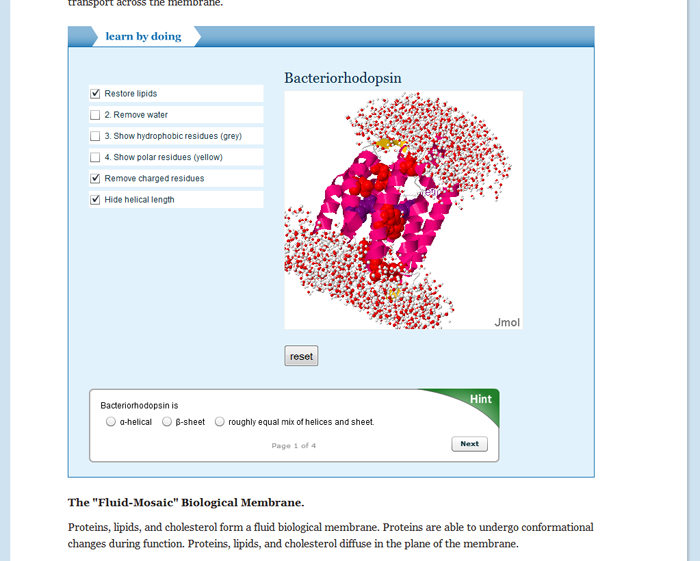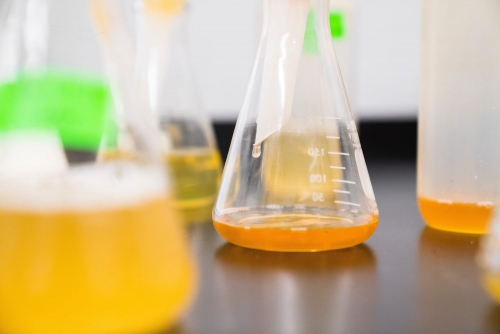General Chemistry 2 is a highly interactive and engaging course that covers all topics typical of second semester General Chemistry. The course includes a multitude of formative practice problems that are scaffolded and include detailed feedback. Learn about Open & Free OLI courses by visiting the “Open & Free features” tab below.
General Chemistry 2 — Open & Free
- Description
- Open & Free features
- Learning objectives by module
- What students will learn
- Course assessments, activities, and outline
- Other course details
- System requirements
Description
This course is intended for Majors and is adapted from OpenStax Chemistry with many additions and modifications including: activities with PHeT simulations; problem sets that revolve around real-world scenarios; interactive examples; simulations, instructor-led videos demonstrating problem solving methods; animations; and more. The course is highly interactive and engaging, designed in a logical flow that transitions smoothly between small amounts of expository text, worked examples, activities, interactives, simulations, and other media.
Adhering to OLI philosophy, this course provides immediate and detailed feedback for its many formative assessment activities, appropriate scaffolding, and clearly aligned learning objectives. General Chemistry 1 covers all content typically covered in the first semester of a college course.
Open & Free features
Open & Free Courses
- Open & Free OLI courses enable independent learners to study a subject on their own terms, at their leisure. Courses are:
- Self-guided.
- Self-paced.
- Self-supported.
- Open & Free courses include only the learning materials:
- No teacher.
- No tests.
- No college credit.
- No certificate of completion.
- *If your teacher gave you a Course Key, do not use an Open & Free course because your teacher will never see your work.
Learning objectives by module
Unit : Chemical Kinetics
Module : Reaction Rates
- Calculate reaction rates from experimental data.
- Determine relative rates of consumption and production of species from the balanced equation for a given chemical reaction.
- Describe the effects of chemical nature, physical state, temperature, concentration, and catalysis on reaction rates.
Module : Rate Laws
- Use rate and concentration data to identify reaction orders and derive rate laws.
- Perform integrated rate law calculations for zero-, first-, and second-order reactions.
- Define half-life and carry out related calculations.
Module : Reaction Mechanisms
- Use the postulates of collision theory to explain the effects of physical state, temperature, and concentration on reaction rates.
- Define the concepts of activation energy and transition state.
- Use the Arrhenius equation in calculations relating rate constants to temperature.
- Derive the rate law consistent with a given reaction mechanism.
- Explain the function of a catalyst in terms of reaction mechanisms and potential energy diagrams.
Unit: Chemical Equilibrium
Module: Concepts of Chemical Equilibrium
- Explain the dynamic nature of equilibrium.
- Calculate values of reaction quotients.
- Calculate values of equilibrium constants, using concentrations and pressures.
- Predict directional shift of a reaction by comparing the values of the reaction quotient and equilibrium constant.
Module: LeChatelier’s Principle
- Predict the response of a stressed equilibrium using Le Châtelier’s principle.
Module: Equilibrium Calculations
- Given a reversible reaction and information about a system at equilibrium, determine values of K or concentration of species at equilibrium.
- Given a reversible chemical reaction with an intermediate value of K and the current state of a system, determine the concentrations of the chemical species that will be present at equilibrium.
- Given a reversible chemical reaction with a large or small value of K, and the current state of a system, determine concentration of chemical species at equilibrium.
Unit: Acids and Bases
Module: Defining and Measuring Acids and Bases
- Identify acids, bases, and conjugate acid-base pairs.
- Use the ion-product constant for water to calculate hydronium and hydroxide ion concentrations.
- Describe the acid-base behavior of amphiprotic substances.
- Perform calculations relating pH and pOH.
Module: Strong and Weak Acids and Bases
- Perform calculations relating Ka and Kb and assess the relative strengths of acids and bases according to these ionization constants.
- Perform calculations relating pH and pOH.
- Carry out equilibrium calculations for weak acid–base systems.
- Apply equilibrium concepts to acids and bases that may donate or accept more than one proton.
- Predict whether a salt solution will be acidic, basic, or neutral.
- Calculate the concentrations of the various species in and pH of a salt solution.
- Rationalize trends in acid–base strength in relation to molecular structure.
Module: Buffers
- Describe the composition and function of acid–base buffers.
- Calculate the pH of a buffer before and after the addition of added acid or base.
Module: Titrations
- Compute sample pH at important stages of a titration.
- Interpret titration curves for strong and weak acid-base systems.
Unit: Equilibria of Other Reaction Classes
Module: Solubility and Complex Ion Equilibria
- Calculate values of solubility equilibrium constants, Ksp, using concentrations.
- Perform calculations relating the solubility equilibrium constant, Ksp, to solubility using concentrations.
- Determine conditions under which precipitation occurs.
- Perform calculations relating Kf values and concentrations of species at equilibrium.
Unit: Thermodynamics
Module: The Second Law of Thermodynamics
- Describe the characteristics of a spontaneous process.
- Explain how the second law of thermodynamics can be used to determine spontaneity.
Module: Free Energy
- Qualitatively and quantitatively determine free energy change for a process using enthalpies of formation and the entropies of reactants and products.
- Use the relation between K and standard free energy change of a chemical reaction to connect observations about a system at equilibrium to the standard free energy.
Unit: Electrochemistry
Module: Foundational Concepts of Electrochemistry
- Define important associated terms of electrochemistry.
- Produce balanced oxidation-reduction equations for reactions in acidic or basic solution.
Module: Galvanic Cells
- Describe the basic components of galvanic cells.
- Use cell notation to describe galvanic cells.
- Determine standard cell potentials for oxidation-reduction reactions.
- Perform calculations that involve converting between cell potentials, free energy changes, and equilibrium constants.
- Use the Nernst equation to determine cell potentials at nonstandard conditions.
Module: Other Applications of Electrochemistry
- Describe batteries and fuel cells.
- List methods used to prevent or slow corrosion.
- Describe electrolytic cells and their relationship to galvanic cells.
- Perform various calculations related to electrolysis.
Unit: Nuclear Chemistry
Module: Nuclear Reactions and Equations
- Describe nuclear structure in terms of protons, neutrons, and electrons.
- Calculate mass defect and binding energy for nuclei.
- Explain trends in the relative stability of nuclei.
- Identify common particles and energies involved in nuclear reactions.
- Write and balance nuclear equations.
- Describe common types of nuclear reactions.
Module: Applications of Nuclear Chemistry
- Calculate kinetic parameters for decay processes, including half-life.
- Describe and perform calculations for common radiometric dating techniques.
- Explain nuclear fission and fusion processes.
- Summarize basic requirements for nuclear fission and fusion reactors.
- List common applications of radioactive isotopes.
- Describe the biological impact of ionizing radiation.
What students will learn
Coming soon.
Course assessments, activities, and outline
Coming soon.
Other course details
System requirements
OLI system requirements, regardless of course:
- internet access
- an operating system that supports the latest browser update
- the latest browser update (Chrome recommended; Firefox, Safari supported; Edge and Internet Explorer are supported but not recommended)
- pop-ups enabled
- cookies enabled
Some courses include exercises with exceptions to these requirements, such as technology that cannot be used on mobile devices.
This course’s system requirements:






